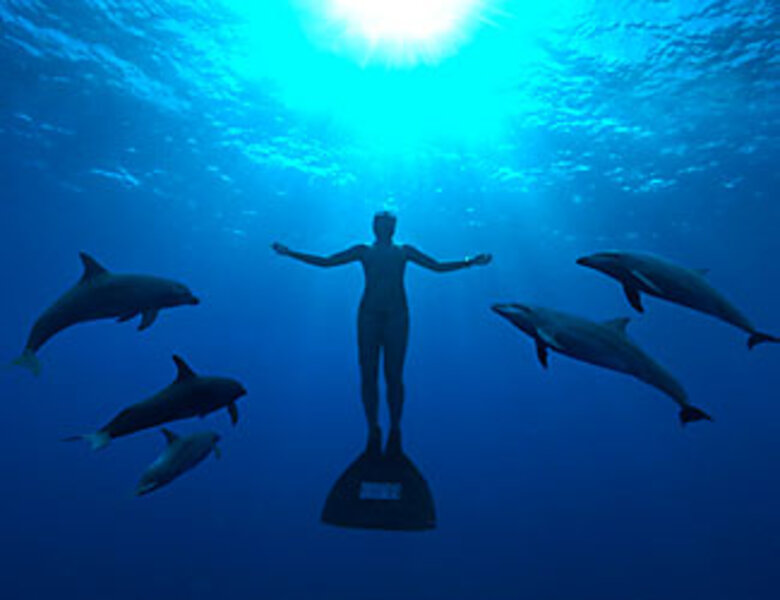Review: 'The Cove'
Every once in a while it's good to see a movie that makes the blood boil. "The Cove," a hit at this year's Sundance Film Festival, is a documentary about dolphin slaughter in Japan that is also a call to arms. The filmmakers literally took their life in their hands to make it.
The latest and one of the best of the current wave of ecodocs, "The Cove" centers on Richard O'Barry, who caught and trained the five dolphins who played Flipper in the smash 1960s TV show. "Flipper" sparked a worldwide craze in all things dolphin. It also helped to create an industry bent on their capture and sale to marine parks. More than half of these mammals – who, in the wild, swim 40 miles a day, dive hundreds of feet, and live in large groups – survive only two years in captivity.
Dolphins not chosen for sport are often butchered for food, palmed off in Japan as whale meat.
Remorseful, O'Barry became a fanatic advocate for dolphin liberation. For "The Cove," he teamed up with director Louie Psihoyos, a famed "National Geographic" photographer and a member of the Oceanic Preservation Society, which also functioned as the film's producer. Together they assembled an "Oceans Eleven"-style team whose job was to record, for the first time, a recurring atrocity in the Japanese fishing village of Taiji.
As Psihoyos explains, Taiji is like a town in a Stephen King novel. With its whale museums and abundant playtime porpoise paraphernalia, it seems outwardly Edenic. But Taiji has a secret cove where the highly acoustic dolphins, deranged by deliberately loud noises made by the fisherman, are herded. Behind high spiked gates, shielded by bluffs, the winnowing takes place as the waters run red.
Because the fishermen, aided by corrupt local politicians and Mafia-like Japanese gangsters called the Yakuza, are so intent on keeping their handiwork a secret, the filmmakers decided to go high-tech. Mandy Rae-Cruickshank, an eight-time world champion free diver, was enlisted with her husband, also a free diver, to set underwater cameras and hydrophones. A former assistant of Psihoyos, who now works as head moldmaker at George Lucas's Industrial Light and Magic, created fake rocks to hide cameras and microphones. A former Canadian Air Force electronics expert souped up the hard-drive cameras with larger drivers used by climbers on Mount Everest. Remote-controlled helicopters were equipped with gyro-stabilized high-definition cameras.
So, with all this firepower, did the good guys win? Yes and no. The Taiji hunts continue but the butchering is so overwhelming that it's difficult to imagine anybody watching it and not being moved to take action.
Since most Japanese are unaware of both the dolphin hunts and the toxicity of the meat (from mercury), the film, if distributed widely could have a profound effect. Each year in Japan, 23,000 dolphins are killed legally, the majority at sea, because the Japanese government and the International Whaling Commission, have not agreed to protect "small cetaceans," even though commercial whaling was outlawed in 1986. In the short term, following the filming of "The Cove," dolphin meat was finally taken off the school lunch menu in Taiji. It's a start.
Lest you think "The Cove" is all facts and figures, be assured it's also a rousing piece of real-world thriller filmmaking. Probably many of us are tired of "Gotcha" documentaries but this one is different. For one thing, its crusade is eminently just. Somewhere up there Flipper is smiling. Grade: A (Rated PG-13 for disturbing content.)





